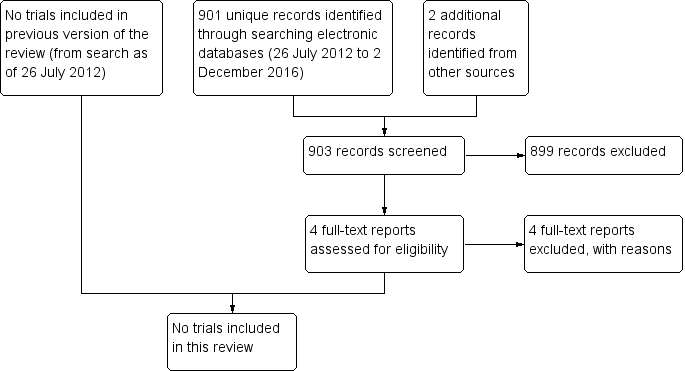Intervenciones no quirúrgicas para el orzuelo interno agudo
Información
- DOI:
- https://doi.org/10.1002/14651858.CD007742.pub4Copiar DOI
- Base de datos:
-
- Cochrane Database of Systematic Reviews
- Versión publicada:
-
- 09 enero 2017see what's new
- Tipo:
-
- Intervention
- Etapa:
-
- Review
- Grupo Editorial Cochrane:
-
Grupo Cochrane de Salud ocular y de la visión
- Copyright:
-
- Copyright © 2017 The Cochrane Collaboration. Published by John Wiley & Sons, Ltd.
Cifras del artículo
Altmetric:
Citado por:
Autores
Contributions of authors
Conceiving the review: KD, KL
Designing the review: KL, JJN
Co‐ordinating the review: KL
Data collection for the review:
-
Designing and undertaking electronic search strategies: Iris Gordon and Lori Rosman
-
Screening search results: KL, JJN
-
Organizing retrieval of papers: KL
-
Screening retrieved papers against inclusion criteria: KL, JJN
-
Appraising risk of bias of papers: KL, JJN
-
Extracting data from papers: KL, JJN
-
Writing to authors of papers for additional information: KL
-
Providing additional data about papers: KL, JJN
-
Obtaining and screening data on unpublished studies: KL, JJN
Data management for the review:
-
Entering data into RevMan: KL, JJN
Analysis of data: KL, JJN, KD
Interpretation of data:
-
Providing a methodological perspective: KL, KD
-
Providing a clinical perspective: JJN
-
Providing a policy perspective: JJN
Writing the review: KL, JJN, KD
Providing general advice on the review: KL, JJN, KD
Securing funding for the review: KD
Updating the review:
-
KL reviewed search results, extracted data, and wrote the review
-
JJN and KD revised and edited the review
We acknowledge Sueko Matsumura and Chris Khanoyan for assistance in screening search results for the update.
Sources of support
Internal sources
-
No sources of support supplied
External sources
-
Grant 1 U01 EY020522, National Eye Institute, National Institutes of Health, USA.
-
National Institute for Health Research (NIHR), UK.
-
Richard Wormald, Co‐ordinating Editor for Cochrane Eyes and Vision (CEV) acknowledges financial support for his CEV research sessions from the Department of Health through the award made by the NIHR to Moorfields Eye Hospital NHS Foundation Trust and UCL Institute of Ophthalmology for a Specialist Biomedical Research Centre for Ophthalmology.
-
The NIHR also funds the CEV editorial base in London.
The views expressed in this publication are those of the review authors and not necessarily those of the NIHR, the NHS or the Department of Health.
-
Declarations of interest
KL: none known.
JJN: none known.
KD: none known.
Acknowledgements
We thank Iris Gordon and Lori Rosman for devising and implementing the electronic search strategy for the review. We thank the Cochrane Eyes and Vision editorial team for assisting with preparation of the protocol, review, and updates to the review. We also thank Barbara Hawkins, Karen Blackhall, Daniel Ezra, and John Bladen for their comments; Takeshi Iwase and Sueko Matsumura for their assistance with evaluating Japanese‐language articles; and Tsung Yu and Xue Wang for their assistance with evaluating Chinese‐language articles. We especially thank Nancy Fitton for her work on writing the Plain Language Summary, and Sarah Money for editing the Plain Language Summary.
Version history
| Published | Title | Stage | Authors | Version |
| 2017 Jan 09 | Non‐surgical interventions for acute internal hordeolum | Review | Kristina Lindsley, Jason J Nichols, Kay Dickersin | |
| 2013 Apr 30 | Interventions for acute internal hordeolum | Review | Kristina Lindsley, Jason J Nichols, Kay Dickersin | |
| 2010 Sep 08 | Interventions for acute internal hordeolum | Review | Kristina Lindsley, Jason J Nichols, Kay Dickersin | |
| 2009 Apr 15 | Interventions for acute internal hordeolum | Protocol | Kristina Lindsley, Jason J Nichols, Kay Dickersin | |
Differences between protocol and review
We added methods related to the production of a 'Summary of findings' table, and assessment of the certainty of the body of evidence, using the GRADE approach. These methods were not included in the protocol or previous versions of this review.
Keywords
MeSH
Medical Subject Headings (MeSH) Keywords
Medical Subject Headings Check Words
Humans;
PICO

Study flow diagram.

